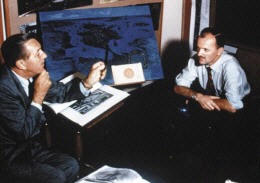First Unit
Director:- Ken Annakin
Unit Manager:- Frank Sherwin Green
Director of Photography:- Guy Green
Camera Operative:- Dave Harcourt
Technicolor Technician:- Ian Craig
Asst. Technicolor Technician:- John Tiley
Clappers:- Derrick Whitehurst
1st. Assistant Director:- Peter Bolton
2nd. Assistant Director:- Peter Manley
3rd Assistant Director:- Kip Gowan
Continuity:- Joan Davis
Sound Mixer:- C.C. Stevens
Boom Operator:- Fred Ryan
Sound Camera:- K Rawkins
Floor Props:- Jim Herald
Floor Electrician:- Maurice Gillet
Floor Stills:- Frank Bellingham
Production Secretary:- Teresa Bolland
Second Unit
Director:- Alex Bryce
Unit Manager:- Anthony Nelson-Keys
Cinematographer:- Geoffrey Unsworth
Camera Operator:- Bob Walker
Technicolor Technician:- Robert Kindred
Asst. Technicolor Technician:- Michael Brandt
1st. Asst. Director:- Basil Keys
2nd. Asst. Director:- Len Lee
3rd Asst. Director:- Chris Sutton
Boom Operator:- George Paternoster
Continuity:- Connie Newton
Clapper Loader:- Ken Nicholson
Asst. Wardrobe:- Fred Gayton
Hairdresser:- A Baber
Floor Props:- Ernie Quick
Floor Stills:- George Ward
Production Secretary:- Kathleen Hosgood
Screenplay:- Lawrence Edward Watkin
Producer:- Perce Pearce
Executive Producer:- Walt Disney
Editor:- Gordon Pilkington
Asst. Editor:- Ann Coates
2nd Asst. Editor:- Deveril Goodman
2nd Asst. Editor:- Leslie Hodgson
2nd Asst. Editor:- Terry Poulton
Casting Director:-Maude Spector
Casting Asst.:- John Owen
Art Director:- Carmen Dillon
Asst. Art Director:- Arthur Lawson
Asst. Art Director:- Jack Stevens
Costume Design:- Michael Whittaker
Wardrobe Supervisor:- Yvonne Caffin
Wardrobe Master:- Goff Price
Wardrobe Mistress:- Mrs Gilbert
Wardrobe Assistant:- Betty Simms
Wardrobe Assistant:- Roy Lemon
Period Advisor:- Charles R. Beard
Makeup Supervisor:- Geoffrey Rodway
Makeup Artist:- Trevor Crole-Rees
Makeup Artist:- Stuart Freeborn
Makeup Artist:- Eddie Knight
Makeup Artist:- A. L. Lawrence
Makeup Artist:- Robert Alexander
Makeup Artist:- Molly Schneiderman
Production Manager:- Douglas Peirce
Chief Draughtsman:- Ernest Archer
Sketch Artist:- Ivor Beddos
Sketch Artist:- Stephen Grimes
Asst. Draughtsman:- John Box
Asst. Draughtsman:- Roy Dorman
Asst. Draughtsman:- Don Picton
Junior Draughtsman:- Peter Lamont
Junior Draughtsman:- Richard Frigg
Sound Editor:- Wyn Ryder
Dubbing Mixer:- Peter Davies
Boom Operator:- Basil Fenton-Smith
Sound Editor:- Winston Ryder
Matte Artist:- Peter Ellenshaw
Matte Effect Technician:- Alan Hulme
Matte Effect Technician:- Peter Hall
Scenic Artist:- Robert Dawe
Set Dresser:- Harry White
Technicolor Colour Consultant:- Joan Bridge
Conductor: Royal Philharmonic Orchestra:- Muir Mathieson
Clapper Loader:- John Alcott
Assembly Cutter:- Anne V. Coates
Assistant Camera:- Peter Hall
Focus Puller:- Alan Hume
Still Photographer:- Ian Jeayes
Still Photographer:- George Courtney Ward
Hair Dressing Supervisor:- Vivienne Walker
Hairdresser:- Joyce Wood
Hairdresser:- Joan White
Hairdresser:- Alf Beeber
Hairdresser:- Gordon Bond
Hairdresser:- Ann Fordyce
Hairdresser:- Pearl Tipaldi
Construction Manager:- Gus Walker
Property Master:- Bill Mason
Production Buyer:- Jim Baker
Production Publicist:- Catherine O’ Brien
Production Publicist:- Joan R. Davis
Producers Secretary:- Denise Carey
Casting Secretary:- Pat Bull
Publicity Secretary:- Nita Oswin
Ballads:- Elton Hayes
Ballads:- Clifton Parker
Ballads:- George Wyle
Ballads and Lyricist:- Eddie Pola
Ballads and Lyricist:- Lawrence Edward Watkin




















